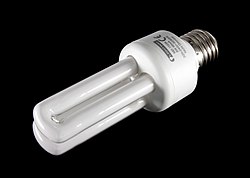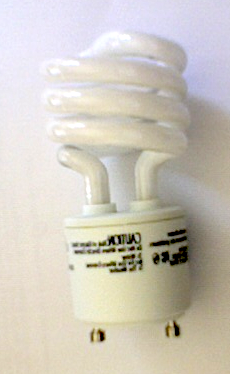
Back مصباح فلوري مدمج Arabic Kompaktėška fluorescentėnė alektras lėmpalė BAT-SMG বিদ্যুৎ সাশ্রয়ী বাতি Bengali/Bangla Làmpada fluorescent compacta Catalan Kompaktní zářivka Czech Kompaktlysstofrør Danish Kompaktleuchtstofflampe German Kompakta fluoreska lampo Esperanto Lámpara fluorescente compacta Spanish Kompaktluminofoorlamp Estonian
A compact fluorescent lamp (CFL), also called compact fluorescent light, energy-saving light and compact fluorescent tube, is a fluorescent lamp designed to replace an incandescent light bulb; some types fit into light fixtures designed for incandescent bulbs. The lamps use a tube that is curved or folded to fit into the space of an incandescent bulb, and a compact electronic ballast in the base of the lamp.
Compared to general-service incandescent lamps giving the same amount of visible light, CFLs use one-fifth to one-third the electric power, and last eight to fifteen times longer. A CFL has a higher purchase price than an incandescent lamp, but can save over five times its purchase price in electricity costs over the lamp's lifetime.[1] Like all fluorescent lamps, CFLs contain toxic mercury,[2] which complicates their disposal. In many countries, governments have banned the disposal of CFLs together with regular garbage. These countries have established special collection systems for CFLs and other hazardous waste.
The principle of operation remains the same as in other fluorescent lighting: electrons that are bound to mercury atoms are excited to states where they will radiate ultraviolet light as they return to a lower energy level; this emitted ultraviolet light is converted into visible light as it strikes the fluorescent coating, and into heat when absorbed by other materials such as glass.
CFLs radiate a spectral power distribution that is different from that of incandescent lamps. Improved phosphor formulations have improved the perceived color of the light emitted by CFLs, such that some sources rate the best "soft white" CFLs as subjectively similar in color to standard incandescent lamps.[3]
White LED lamps compete with CFLs for high-efficiency lighting.[4] General Electric has since stopped production of domestic CFL lamps in the United States in favour of LEDs.[5]
- ^ "Compact Fluorescent Light Bulbs". Energy Star. Archived from the original on 2008-09-16. Retrieved 2010-09-30.
- ^ "CFL Bulbs Have One Hitch: Toxic Mercury". National Public Radio. Retrieved 2007-02-15.
- ^ Masamitsu, Emily (May 2007). "The Best Compact Fluorescent Light Bulbs: PM Lab Test". Popular Mechanics. Archived from the original on April 26, 2007. Retrieved 2007-05-15.
- ^ Amber Angelle, "Will LED Light Bulbs Best Your CFLs and Incandescents?" Popular Mechanics August 4, 2010 accessed May 30, 2011
- ^ "Say Goodbye. Say Hello". February 2016. Archived from the original on 2016-10-22. Retrieved 2016-12-19.


